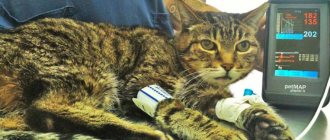Anastasia Dmitrievna Mitryaykina
veterinarian Petstory
Normal temperature in cats is one of the most important indicators of health. Changes in body temperature, up or down, can significantly affect your pet's health, and sometimes the consequences can be fatal.
- Heat
Factors affecting temperature
Age
Before the age of 10 days (neonatal period), kittens cannot independently maintain their body temperature. They are heated by the warmth of the mother or other external sources (heating pads). The normal body temperature of a newborn kitten is from 35 to 36 degrees, but it also directly depends on the temperature in the nest.
If there is no mother, or for some reason she does not care for the offspring, the owner will have to take care of the babies. Place heating pads in the nest. If it is electric, then select the weakest mode on it. If you place water in a bottle, then its temperature should be about 40 degrees. Cover the bottle with several layers of blankets. If you are using a red lamp, it is important to place the thermometer at the warmest point. The temperature should not exceed 30 degrees, otherwise the babies may overheat.
By the age of one month, a kitten’s temperature of 38 degrees is considered normal. Further, adult animals have a normal temperature; it can fluctuate depending on various factors, but always remains within the range of 37.5–39 degrees. Older pets tend to be less active and their body temperature rarely exceeds 38 degrees Celsius.
Activity
In general, if a furry couch potato is calm, its temperature will be lower than that of an active and cheerful cat, such as an Abyssinian or Burmese breed.
Times of Day
In the morning the result is usually lower than in the afternoon. The cat is a twilight predator, and all its vital processes occur more actively in the evening.
Overweight
Overweight animals usually have a lower body temperature than moderately well-fed animals.
Activities to help reduce fever
Before carrying out any activities, you need to qualitatively measure the temperature; if there are numbers around 39.5, you need to observe the animal. After an hour, you can measure again, when the data reaches 40.5 degrees, you need to call the veterinarian and try to bring down the kitten’s fever before he arrives:
- First, to bring down the fever, you can moisten the kitten's hair with water.
- Ice should be applied to the kitten's groin area.
- Drinking more water will help bring down the fever. Kittens should always have water in their bowl during this period of time. When the pet refuses to drink, it is necessary to give infusions using a syringe, from which the needle must first be removed.
- You can reduce the fever at home by using a wet towel to wrap your pet in.
Cats should not be treated with medications intended for humans to reduce their fever. If you have a fever and high thermometer readings, you should urgently take your cat to the veterinarian.
Table with standards
| T/age | Up to 10 days | 10–30 days | month–10 years | Older |
| 35–37 | norm | normal/reduced | downgraded | downgraded |
| 37–38 | normal/increased | norm | downgraded | reduced/normal |
| 38–39 | Promoted | increased/normal | norm | norm |
| more than 39 | Promoted | increased | increased | increased |
Treatment
In addition to rest and drinking plenty of fluids, antibiotics are commonly used to treat fever in cats. Getting your cat to take medications, as well as taking his temperature, is not easy, but it is very important. If he spits out the pill or doesn't eat the cat food you hid it in, use these great tips on how to give pills to your pet. One of them is to wrap the animal in a towel for its comfort and safety. It would be nice to get an assistant to cope with this non-trivial task.
In some cases, your veterinarian may recommend a liquid medication for hyperthermia, which is easier to give.
It's not easy to watch your fur baby suffer from a fever, but beyond the medical care instructions your veterinarian has prescribed, there are some steps you can take to prevent the illness from developing. Regular cat care (brushing teeth, trimming nails) and periodic checkups (checking ears, monitoring her eating and drinking habits) will help lay an excellent foundation for a healthy life for your pet.
And don't forget to hug the cat. A little love will help your pet get better faster!
Reasons for temperature deviation from normal
Heat
Basically, when people talk about fever in cats, they mean hyperthermia.
Such a nuisance can occur for many reasons, but mainly it is due to the body's reaction to inflammation or pain. Elevated ambient temperatures, prolonged exposure to hot rooms or direct sunlight can cause hyperthermia. If your cat has a high temperature, stress may also be the cause.
Low temperature
Hypothermia can be noted in cats in a state of general loss of strength and dehydration, and in small kittens - if they are left without an external source of heat. If your cat has a low temperature, it may be due to hypothermia.
External signs of temperature change
Depending on what temperature the cat is, he may behave and feel in a certain way. The table shows the following common symptoms of hypo- and hyperthermia:
| № | Signs of hyperthermia | Symptoms of hypothermia |
| 1. | Lack of appetite, thirst | Lack of appetite and thirst |
| 2. | Restless state | Lethargy, a state where you can lift an animal by the scruff of the neck like a rag |
| 3. | Excessive sleep | The cat tends to bury itself in warm things or be closer to the heat source |
| 4. | Tremors, convulsions | The wool is ruffled |
| 5. | High pulse, rapid breathing | Low pulse, blood pressure |
| 6. | Digestive disorders | Breathing slow |
| 7. | Watery eyes, runny nose | Paleness of the skin and mucous membranes |
| 8. | Inflammation of the oral mucosa and genital organs |
Reasons for the increase
High temperatures can be caused by serious disturbances in the cat's functioning. Common causes of fever are:
- poisoning;
- infection;
- exacerbation of a chronic disease;
- viral infection;
- poor nutrition.
Any of the factors can lead to serious consequences and even the death of the pet.
Reasons for the downgrade
Most often, hypothermia occurs due to hypothermia in the pet. Spending a long time outside in cold weather or being under air conditioning can lead to this result. This condition can also occur against the background of suppressed immunity. Weakened, after illness or injury, the body stops fighting pathogenic organisms, which leads to a decrease in performance.
In addition, low levels are a sign of problems with the central nervous system, bone marrow pathologies and oncology. This is often how kidney failure and cardiovascular diseases first manifest themselves.
When wondering what temperature is considered low in cats, you should take into account the characteristics of your pet. However, readings below 37 require immediate action.
How can you tell if your cat has a fever?
Signs of general malaise in your furry friend should always be cause for concern. The most important indication that a pet’s body temperature should be measured is a change in its behavior: decreased activity, refusal of usual play, desire to hide. You may also notice that your cat has become worse at eating or has completely abandoned its usual food.
Without thermometry, it is impossible to know whether there is a temperature.
There is a well-established belief that if a pet has a dry and warm nose, it has a fever. But if it’s wet and cold, then everything is fine. In fact, even a completely healthy cat can have a dry and warm nasal mucosa, for example, after sleep. You should not pay attention to this sign, and if in doubt, you need to measure the temperature rectally.
Thermoregulation of cats
Thermoregulation is the ability of animals to maintain body temperature within the most suitable range for life, even if the ambient temperature differs significantly. Cats are mammals. To determine the surrounding temperature, they, like other representatives of this group, have special sensitive organs located in the skin - these are cold and heat receptors.
A receptor is a sensitive nerve ending or specialized cell that converts perceived stimulation into nerve impulses, which, in turn, transmit information to the brain.
The number of cold and heat receptors in cats is not the same. There are much more of the first, and they are not very deep in relation to the surface of the skin; heat receptors are located deeper. This is why almost all cats love warmth and only in extreme heat do they prefer cool places.
Cold receptors are closer to the surface of the skin than heat receptors
Cats have several ways to maintain normal body temperature:
- Sweating. Cats don't sweat like people. There are few sweat glands on their body, and they are not able to remove enough fluid from the body to maintain normal body temperature. Therefore, cats cannot effectively get rid of “excess” heat in this way.
- Licking. For a cat, this is not just a sign of cleanliness, but a necessary procedure for maintaining thermal balance. When licking, a moisture-repellent layer is formed on the fur, which helps maintain the desired body temperature. This procedure also stimulates the glands located deep in the skin, which secrete a special substance - sebum. It reduces the amount of ultraviolet rays penetrating the skin and slows down the release of moisture from the surface of the skin without preventing air from entering. Sebum protects the animal well from moisture and temperature fluctuations in the environment. In winter, licking helps cats retain heat, and in summer, it increases heat transfer by increasing the space between the fur hairs, which opens up air flow to the skin.
- Acceleration of breathing. The main way cats increase heat output. As the air temperature rises, the cat begins to breathe more often. From the outside it looks like shortness of breath: the mouth is open, breathing is shallow. Under normal temperature conditions, a cat makes approximately 30 inhalations/exhalations per minute; in hot weather, their number increases several times.
When severely overheated, a cat begins to breathe with an open mouth, which increases heat transfer in the body.
The listed cooling methods are not always enough. It happens that the best way to avoid overheating is to simply go into the shade. This is what cats do if their health worsens due to the heat.
There are breeds that are more prone to overheating, such as longhaired breeds. They experience heatstroke faster.
Changing body position allows cats to both increase heat transfer and retain heat. For example, in the summer you can often see whiskered animals lying stretched out in the sun, and animals behave the same way near the radiator in winter. But as soon as it gets cooler, the cat immediately curls up into a ball.
Like other mammals, cats can retain body heat by contracting small blood vessels in the skin: in the cold, the vessels narrow, and heat transfer decreases; in heat, they expand, and heat transfer, accordingly, increases. In addition, cats can fluff up, thus increasing in volume. The air gap formed in this case reduces heat loss, and the cat does not freeze. Hairless cats have a more difficult time in this regard; in the cold they freeze very quickly.
By fluffing up its fur, a cat reduces heat loss
The methods of heat regulation described above apply more to adult cats. Kittens do not immediately become capable of independent thermoregulation. At temperatures below 18°C, children may freeze.
How to measure body temperature in cats at home?
Many cats experience stress when leaving their familiar home, and going to the veterinary clinic can be a real ordeal for these animals. Therefore, sometimes the owner may need to independently measure the pet’s body temperature at home.
It is important to remember that ensuring the safety of all participants in the process is your direct responsibility. Therefore, if in doubt, it is better to entrust the procedure to professionals. In any case, do not try to perform weighted manipulations.
Use a bag, muzzle and collar to restrain your cat and protect it from its claws and teeth. If you don’t have these devices, try to carefully swaddle the cat with a towel or blanket. Involve an assistant in the procedure. Don't frighten the patient. It is better to measure an animal's body temperature rectally - with an electronic or mercury thermometer.
Hurry up, choose a box and find out what gift awaits you
Discount on pet insurance
Promo code copied to clipboard
Measurement with a children's electronic thermometer
The best option for measuring body temperature in cats is to do it rectally. The children's electronic thermometer is atraumatic (flexible, soft), has a small tip, and is easy to handle. To measure an animal's temperature with it:
- treat the tip of the thermometer with an antiseptic;
- apply any fatty cream or ointment to the tip;
- insert the tip of the thermometer rectally (no more than 1.5 cm);
- wait for the sound signal;
- remove carefully;
- re-treat the thermometer with an antiseptic.
Measuring temperature with a mercury thermometer
This method gives a more accurate result, but it will take longer and more reliably to fix the patient, since it is more traumatic. It partially repeats the measurement described above:
- treat the tip of the thermometer with an antiseptic;
- apply any fatty cream or ointment to the tip;
- insert the tip of the thermometer rectally (no more than 1.5 cm);
- wait 6 minutes;
- carefully remove the tip of the thermometer;
- re-treat the thermometer with an antiseptic.
Infrared thermometer
can be used by applying from the inner surface of the ear. But the error of such a measurement is quite large, and it cannot be considered accurate.
Measuring with a thermometer
As we wrote above, the only accurate method for determining temperature is measurement with a thermometer. For animals, two types of thermometers are usually used: ear and rectal. The earphone is a convenient modern device that is much easier to use. But still, the rectal one is most often used, since for measurements in this case a regular children's model of an electronic thermometer can be used.
How exactly do you take a rectal measurement? The procedure will require two people. One will take measurements, the second will hold the animal and calm it down. If this is standard procedure for your cat, then most likely she will not resist. And if you are doing this for the first time, difficulties may arise. If the animal is aggressive, it is better not to carry out the procedure, as the pet may injure itself and you.
So, take a thermometer. Treat the tip with alcohol, and then lubricate it with Vaseline. Lift the cat's tail and insert the thermometer into the hole using a screwing motion. The insertion depth should be about 2 cm. Now your task is to hold the thermometer until accurate data is obtained. Sometimes after the sound signal you need to hold the thermometer for about 30 seconds and remove it only when the temperature stops rising. Now evaluate the result and wipe the thermometer with alcohol again.
How to measure the temperature in the ear? First you need to calm the animal, show it the thermometer, and give it a sniff. Next, you can take measurements. In principle, even one person can do this. Wipe the tip of the thermometer, carefully insert the thermometer into the ear, but not very deeply. Now wait for the signal and add a few more seconds until the temperature stops rising. Take out the thermometer and wipe it again with alcohol.
What to do if cats have a fever?
First of all, it is worth noting that the result of changes in body temperature in cats is not as important as the patient’s well-being.
This means that if the pet is cheerful, active, plays, has an excellent appetite, and an increase in body temperature
insignificantly, he needs to be provided with gentle treatment and special conditions. This means being in a comfortable, well-ventilated room, unlimited access to fresh drinking water and peace. It is necessary to observe the animal and repeat the measurements no earlier than half an hour later. If the cat is lethargic, not as playful as usual, is not interested in what is happening, refuses to eat, or you notice other symptoms (vomiting, diarrhea, itching), then this is a reason to immediately consult a veterinarian.
If hyperthermia is associated with external factors, they, of course, need to be eliminated - ventilate the room, turn on the air conditioning. You can wet your paws, belly and head with water at room temperature.
Under no circumstances should you try to reduce the temperature yourself. The use of some “human” antipyretics (for example, paracetamol) can lead to the death of a cat.
If you experience hypothermia
cats, but she feels fine, try to provoke her into active actions - play with her, feed her, replace the thermometer. Repeat the measurements.
If your cat is cold, place her in a warm place with a heating pad nearby (if you don't have one, wrap hot water bottles in towels).
It is worth mentioning separately that a decrease in temperature is a common consequence of anesthesia and muscle relaxation. This condition can be life-threatening, so until all indicators are completely stabilized, it is better to leave the animal under the supervision of specialists. If you take the patient home, strictly follow the recommendations of the attending physician.
Thus, a significant and persistent change in a cat’s body temperature is always a reason to seek help from specialists.
Possible causes of hypo- and hyperthermia
Hyperthermia is an increase in body temperature, and hypothermia is a decrease in body temperature. Temperature changes can occur under the influence of cooling or heating of the environment, metabolic reactions in the cat's body. The nervous system is responsible for maintaining normal temperature balance (thermoregulation); central and autonomic disorders can lead to temperature changes.
The main reasons for the rise in temperature
- infectious and inflammatory diseases - panleukopenia, calicivirosis, rhinotracheitis, mastitis, endometritis, cholangitis, pancreatitis, menignitis, abscess and others;
- reaction to vaccination;
- surgery;
- acute poisoning;
- heat damage due to prolonged exposure to the sun, especially in a locked room or car;
- hyperfunction of the thyroid gland (thyrotoxicosis);
- malignant tumor.
Reasons for the decrease in temperature
- hypothermia;
- anemia due to helminth infestation or internal bleeding;
- severe exhaustion;
- thyroid insufficiency (hypothyroidism);
- terminal stage of the disease - cancer, chronic renal failure;
- suffered a serious illness - the temperature may be reduced for several weeks during the recovery period.
With a traumatic brain injury, stroke, or severe stress, body temperature can either increase or decrease.
A cat's temperature is measured rectally using a mercury or electronic thermometer.


![Temperature in cats [normal, elevated, decreased]](https://zooservice-osetia.ru/wp-content/uploads/temperatura-u-koshek-normalnaya-povyshennaya-ponizhennaya-330x140.jpg)








